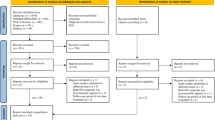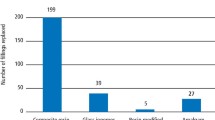Abstract
Data sources
Cochrane Oral Health Group's Trials Register, the Cochrane Central Register of Controlled Trials (CENTRAL), Medline, Embase and LILACS. Hand searched relevant journals and attempted contact with authors of unpublished studies and manufacturers.
Study selection
Randomised controlled trials comparing dental resin composites with dental amalgams in permanent posterior teeth with a minimum follow up of three years were eligible.
Data extraction and synthesis
Data were extracted independently by a minimum of two review authors using specially designed data extraction forms. Risk of bias was assessed using the Cochrane risk of bias tool. Relative risks and 95% CIs were extracted for dichotomous data and mean difference (MD) or standardised mean difference (SMD) for continuous data. Relative risk was combined in a meta-analysis.
Results
Seven studies were included. Two were parallel and five split-mouth design. Data from 871 participants were available from the two parallel studies but several of the split-mouth studies did not report the number of participants. All studies were considered at high risk of bias. Only data from the two parallel studies were included in the primary meta-analysis. Failure rates in these studies were recorded for between five and seven years. The risk ratio of failure for composite versus amalgam was 1.89 with 95% CI of 1.52–2.35. The increased failure was primarily due to caries rather than fracture.
Conclusions
There is low-quality evidence to suggest that resin composites lead to higher failure rates and risk of secondary caries than amalgam restorations.
Similar content being viewed by others
Log in or create a free account to read this content
Gain free access to this article, as well as selected content from this journal and more on nature.com
or
References
Bernardo M, Luis H, Martin MD, Leroux BG, Rue T, Leitão J, et al. Survival and reasons for failure of amalgam versus composite posterior restorations placed in a randomized clinical trial. JADA 2007; 138: 775–783.
Soncini JA, Maserejian NN, Trachtenberg F, Tavares M, Hayes C . The longevity of amalgam versus compomer/ composite restorations in posterior primary and permanent teeth: findings from the New England Children's Amalgam Trial. JADA 2007; 138: 763–767.
Mackey TK, Contreras JT, Liang BA . The Minamata Convention on Mercury: attempting to address the global controversy of dental amalgam use and mercury waste disposal. Sci Total Environ 2014; 472: 125–129.
Author information
Authors and Affiliations
Additional information
Address for correspondence: Cochrane Oral Health Group, School of Dentistry, The University of Manchester, Coupland 3 Building, Oxford Road, Manchester, UK. M13 9PL E-mail: cohg@manchester.ac.uk
Rasines Alcaraz MG, Veitz-Keenan A, Sahrmann P, Schmidlin PR, Davis D, Iheozor-Ejiofor Z. Direct composite resin fillings versus amalgam fillings for permanent or adult posterior teeth. Cochrane Database Syst Rev 2014; 3: CD005620.
This paper is based on a Cochrane Review published in the Cochrane Library 2014, issue 3 (see www.thecochranelibrary.com for information). Cochrane Reviews are regularly updated as new evidence emerges and in response to feedback, and the Cochrane Library should be consulted for the most recent version of the review.
Rights and permissions
About this article
Cite this article
Hurst, D. Amalgam or composite fillings — which material lasts longer?. Evid Based Dent 15, 50–51 (2014). https://doi.org/10.1038/sj.ebd.6401026
Published:
Issue date:
DOI: https://doi.org/10.1038/sj.ebd.6401026
This article is cited by
-
Success rates of manual restorative treatment (MRT) with amalgam in permanent teeth in high caries-risk Filipino children
Clinical Oral Investigations (2015)



